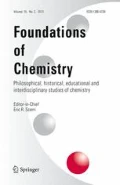Abstract
This work explores the nature of chemistry as an autonomous science and philosophical consequences of generalizations of some chemical aspects. Chemistry is regarded in its distinction from physics, going back to the alchemical aim for the ultimate experiment rather than for all explaining theory. Topology, shape, valence etc. are identified as typically chemical concepts. The contribution of chemistry to the general theory of complexity is demonstrated by approach of diminishing interactions by which smaller and smaller energy increments are needed to move from one level to another one of higher complexity.
Similar content being viewed by others
REFERENCES
F. Arndt, E. Scholz and P. Nachtwey, Berichte 57: 1903, 1924.
F. Arndt, Berichte 63: 2963, 1930.
P.W. Atkins, General Chemistry, Scientific American Books, W.H. Freeman & Co., New York, N.Y., 1989, p. 826.
S. Borman, Chem. Eng. News 75: 43, 1997.
M. Eliade, Forgerons et alchimistes, Flammarion, Paris, 1977.
R. Feynman, The Character of Physical Law, Cox and Wyman LTD, London, 1965.
L. Geymonat, Galileo Galilei, Giulio Einaudi, 1957.
W. Heitler and F. London, Wechselwirkung neutraler Atome und homöopolare Bindung nach der Quantenmechanik. Z. Phys. 44: 455, 1927.
C.K. Ingold, J. Chem. Soc. 1120, 1933; Chem Rev. 15: 225, 1934.
A. Kekulé, Ann. 162: 77, 1872.
K. Lorenz, Die Rückseite des Spiegels. Versuch einer Naturgeschichte menschlichen Erkennens, Piper & Co. Verlag, München, Zürich, 1988.
J.N. Murrell, S.F.A. Kettle and J.M. Tedder, Valence Theory, J. Wiley & Sons Ltd., London, 1976, p. 358.
R. Musil, Der Mann ohne Eigenschaften, Rowohlt, 1930.
W. Pauli, Der Einfluss archetypischer Vorstellungen auf die Bildung naturwissenschaftlicher Theorien bei Kepler, Walter-Verlag AG, Olten, 1970.
L. Pauling, Interview with the Editor. Chem. Intellig. 1: 5, 1995.
K.R. Popper, Logik der Forschung (1934), Mohr. Tübingen, 1971. (English translation: The Logic of Scientific Discovery, Hutchinson, London, 1959.)
H. Primas, Chemistry, Quantum Mechanics and Reductionism, Springer, Berlin, 1983.
H. Primas, Chem. Zeit 19: 109, 1985.
V.L. Rabinovich, Alhimija kak fenomen srednjvekovoj kulturi, Nauka, Moskva, 1979.
R. Robinson, Two Lectures on an 'Outline of an Electrochemical (Electronic) Theory of the Course of Organic Reactions', The Institute of Chemistry of Great Britian and Ireland, London, 1932; J. Soc. Dyers Colourists, Jubilee Issue, 1934: 65.
E.R. Scerri, The Periodic Table and the Electron. American Scientist 85: 546–553, 1997.
A. Simon, Angew. Chem. Int. Ed. Engl. 36: 1789, 1997.
G.E. Stahl, Opusculum Chymico-Physico-Medicum, Halle et Magdeburgiae, 1715, 1740.
R.C. Weast (Ed.), Handbook of Chemistry and Physics, 51st edn, The Chemical Rubber Co., Cleveland, OH, 1970, p. F-158.
Author information
Authors and Affiliations
Rights and permissions
About this article
Cite this article
VanČik, H. Opus Magnum: An Outline for the Philosophy of Chemistry. Foundations of Chemistry 1, 239–254 (1999). https://doi.org/10.1023/A:1009989903921
Issue Date:
DOI: https://doi.org/10.1023/A:1009989903921



